Melitaea phoebe
Melitaea phoebe, the knapweed fritillary,[1] is a butterfly of the family Nymphalidae.[2] It is found in the Palearctic realm, except the northernmost locations. It used to include Melitaea telona, recently revalidated as a distinct cryptic species.
| Knapweed fritillary[1] | |
|---|---|
_underside_Bulgaria.jpg.webp) | |
| male | |
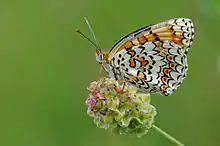 | |
| female | |
| Scientific classification | |
| Kingdom: | |
| Phylum: | |
| Class: | |
| Order: | |
| Family: | |
| Genus: | |
| Species: | M. phoebe |
| Binomial name | |
| Melitaea phoebe | |
| Synonyms[1] | |
|
Papilio phoebe Denis & Schiffermüller, 1775 | |
Description
The wingspan is 34–50 mm. M. phoebe. The largest Melitaea of the Old World, at least certain of its forms. The forewing much more pointed than in the previous species; equally variable in colour as well as the distinctness of the markings.The black markings are usually united, in some cases even covering nearly the whole wings, but in other cases may be strongly reduced. It is characteristic for this species that the reddish yellow submarginal lunate spot situated between the two median veins reaches with its vertex considerably farther into the disc than the other yellow lunate spots. This is especially the case on the forewing, but also on the hindwing the submarginal lunule between the 1. and 2. median veins projects farther basad than the others of the same row.[3]
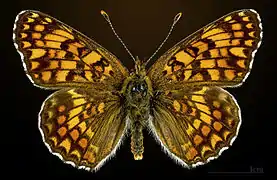 Male
Male Male underside
Male underside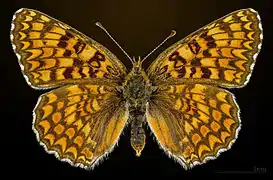 Female
Female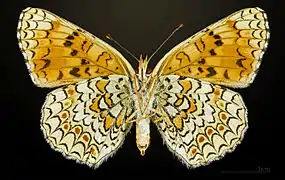 Female underside
Female underside
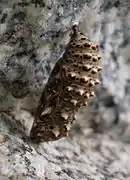 Pupa
Pupa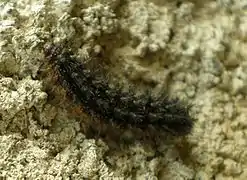 Larva
Larva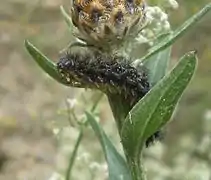 Larva
Larva
Biology
The butterfly flies from April to September depending on the location. The larvae feed on Plantago and Centaurea species (including Centaurea jacea).
References
- Melitaea phoebe
- Savela, Markku. "Melitaea phoebe (Denis & Schiffermüller, 1775)". Lepidoptera and Some Other Life Forms. Retrieved 23 June 2018.
- Seitz. A. in Seitz, A. ed. Band 1: Abt. 1, Die Großschmetterlinge des palaearktischen Faunengebietes, Die palaearktischen Tagfalter, 1909, 379 Seiten, mit 89 kolorierten Tafeln (3470 Figuren)
 This article incorporates text from this source, which is in the public domain.
This article incorporates text from this source, which is in the public domain.
| Wikimedia Commons has media related to Melitaea phoebe. |

